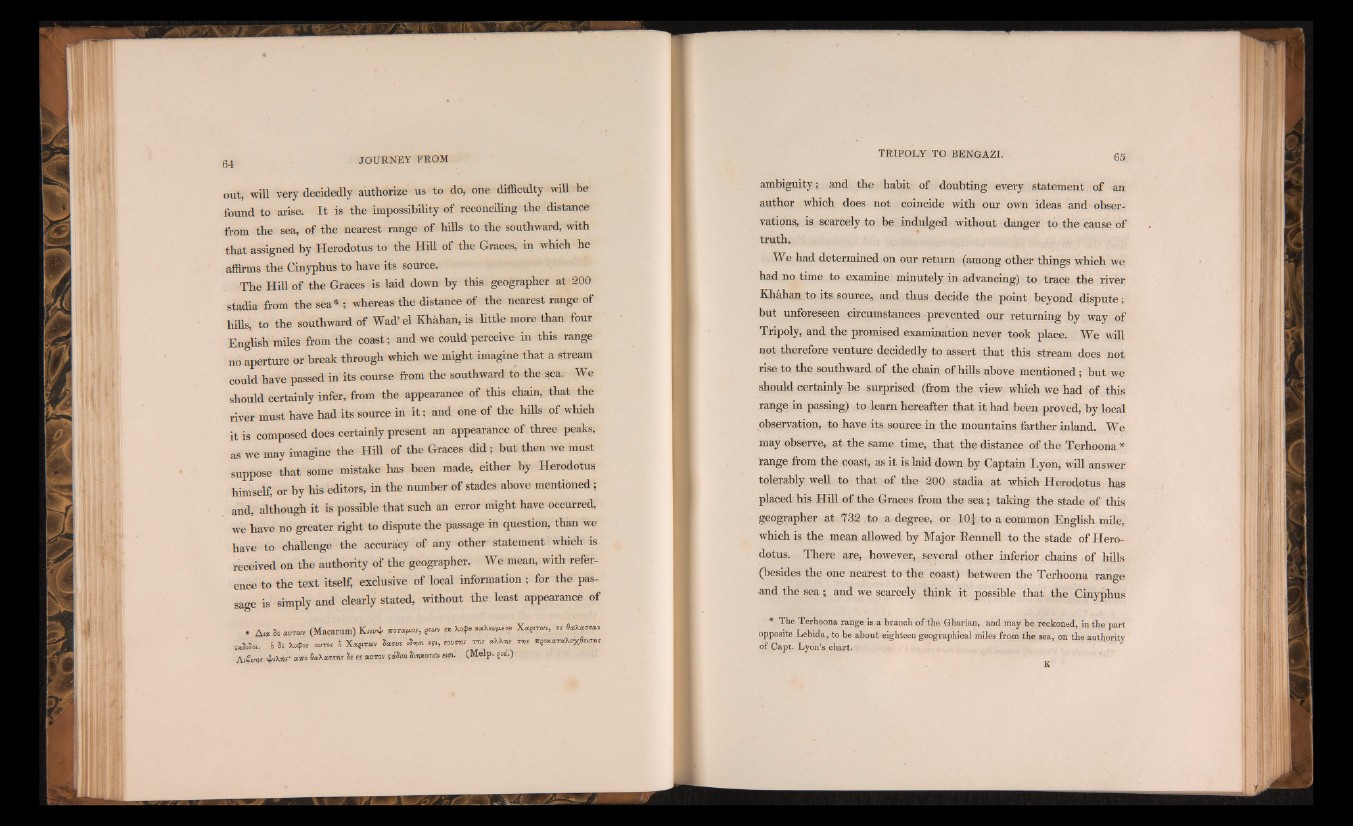
out, will very decidedly authorize us to do, one difficulty will be
found to arise. I t is the impossibility of reconciling the distance
from the sea, of the nearest range of hills to the southward, with
that assigned by Herodotus to the Hill of the Graces, in which he
affirms the Cinyphus to have its source.
The Hill of the Graces is laid down by this geographer at 200
stadia from the sea* ; whereas the distance of the nearest range of
hills, to the southward of Wad’ el Khkhan, is little more than four
English miles from the coast; and we could perceive in this range
no aperture or break through which we might imagine that a stream
could have passed in its course from the southward to the sea. We
should certainly infer, from the appearance of this chain, that the
river must have had its source in i t ; and one of the hills of which
it is composed does certainly present an appearance of three peaks,
as we may imagine the Hill of the Graces did ; but then we must
suppose that some mistake has been made, either by Herodotus
himself, or by his editors, in the number of stades above mentioned ;
and, although it is possible that such an error might have occurred,
we have no greater right to dispute the passage in question, than we
have to challenge the accuracy of any other statement which is
received on the authority of the geographer. We mean, with reference
to the text itself, exclusive of local information ; for the passage
is simply and clearly stated, without the least appearance of
« Am Se m m (Macarum) K.ve4 w o r ^ s , s* M>« gj iW jk )
«Mo., h is ovm 5 Xagmw Mow .Soto, Mt/ow rw ciKKr,s m s sspxxr,A*xfitms
fi£vns +.JW a « SxXajar. is es ottov Smxoaioi sun. (Melp. gob)
ambiguity; and the habit of doubting every statement of an
author which does not coincide with our own ideas and observations,
is scarcely to be indulged without danger to the cause of
truth.
We had determined on our return (among other things which we
had no time to examine minutely in advancing) to trace the river
KMhan to its source, and thus decide the point beyond dispute;
but unforeseen circumstances prevented our returning by way of
Tripoly, and the promised examination never took place. We will
not therefore venture decidedly to assert that this stream does not
rise to the southward of the chain of hills above mentioned; but we
should certainly be surprised (from the view which we had of this
range in passing) to learn hereafter that it had been proved, by local
observation, to have its source in the mountains farther inland. We
may observe, at the same time, that the distance of the Terhoona*
range from the coast, as it is laid down by Captain Lyon, will answer
tolerably well to that of the 200 stadia at which Herodotus has
placed his Hill of the Graces from the sea; taking the stade of this
geographer at . 732 to a degree, or 10| to a common English mile,
which is the mean allowed by Major Eennell to the stade of Herodotus.
There are, however, several other inferior chains of hills
(besides the one nearest to the coast) between the Terhoona range
and the sea; and we scarcely think it possible that the Cinyphus
* The Terhoona range is a branch o f the Gharian, and may be Teckoned, in the part
opposite Lebida, to be about eighteen geographical miles from the sea, on the authority
of Capt. Lyon’s chart.